Leadership and Culture: Challenges, Theories, and Strategies Report
VerifiedAdded on 2023/01/10
|17
|4801
|31
Report
AI Summary
This report delves into the critical aspects of leadership and organizational culture, examining the challenges faced by leaders in a dynamic global environment. It explores macro challenges like lead generation, capital raising, and increased competition, alongside micro challenges such as managing change, performance, and employee turnover. The report also addresses the complexities of cross-cultural teams, motivational factors, and business ethics. Furthermore, it provides an overview of various leadership theories, including the Great Man theory, Trait theory, and Behavioral theory, with specific attention to autocratic, democratic, and transformational leadership styles. The report concludes by highlighting the importance of adapting leadership styles to different situations, referencing the Contingency theory and Situational leadership theory. The report emphasizes the importance of understanding and managing challenges to achieve organizational success.

qwertyuiopasdfghjklzxcvbnmqwe
rtyuiopasdfghjklzxcvbnmqwertyu
iopasdfghjklzxcvbnmqwertyuiopa
sdfghjklzxcvbnmqwertyuiopasdfg
hjklzxcvbnmqwertyuiopasdfghjkl
zxcvbnmqwertyuiopasdfghjklzxcv
bnmqwertyuiopasdfghjklzxcvbnm
qwertyuiopasdfghjklzxcvbnmqwe
rtyuiopasdfghjklzxcvbnmqwertyu
iopasdfghjklzxcvbnmqwertyuiopa
sdfghjklzxcvbnmqwertyuiopasdfg
hjklzxcvbnmqwertyuiopasdfghjkl
zxcvbnmqwertyuiopasdfghjklzxcv
bnmqwertyuiopasdfghjklzxcvbnm
qwertyuiopasdfghjklzxcvbnmqwe
rtyuiopasdfghjklzxcvbnmrtyuiopa
LEADERSHIP AND CULTURE
6/12/2019
Student name
rtyuiopasdfghjklzxcvbnmqwertyu
iopasdfghjklzxcvbnmqwertyuiopa
sdfghjklzxcvbnmqwertyuiopasdfg
hjklzxcvbnmqwertyuiopasdfghjkl
zxcvbnmqwertyuiopasdfghjklzxcv
bnmqwertyuiopasdfghjklzxcvbnm
qwertyuiopasdfghjklzxcvbnmqwe
rtyuiopasdfghjklzxcvbnmqwertyu
iopasdfghjklzxcvbnmqwertyuiopa
sdfghjklzxcvbnmqwertyuiopasdfg
hjklzxcvbnmqwertyuiopasdfghjkl
zxcvbnmqwertyuiopasdfghjklzxcv
bnmqwertyuiopasdfghjklzxcvbnm
qwertyuiopasdfghjklzxcvbnmqwe
rtyuiopasdfghjklzxcvbnmrtyuiopa
LEADERSHIP AND CULTURE
6/12/2019
Student name
Paraphrase This Document
Need a fresh take? Get an instant paraphrase of this document with our AI Paraphraser
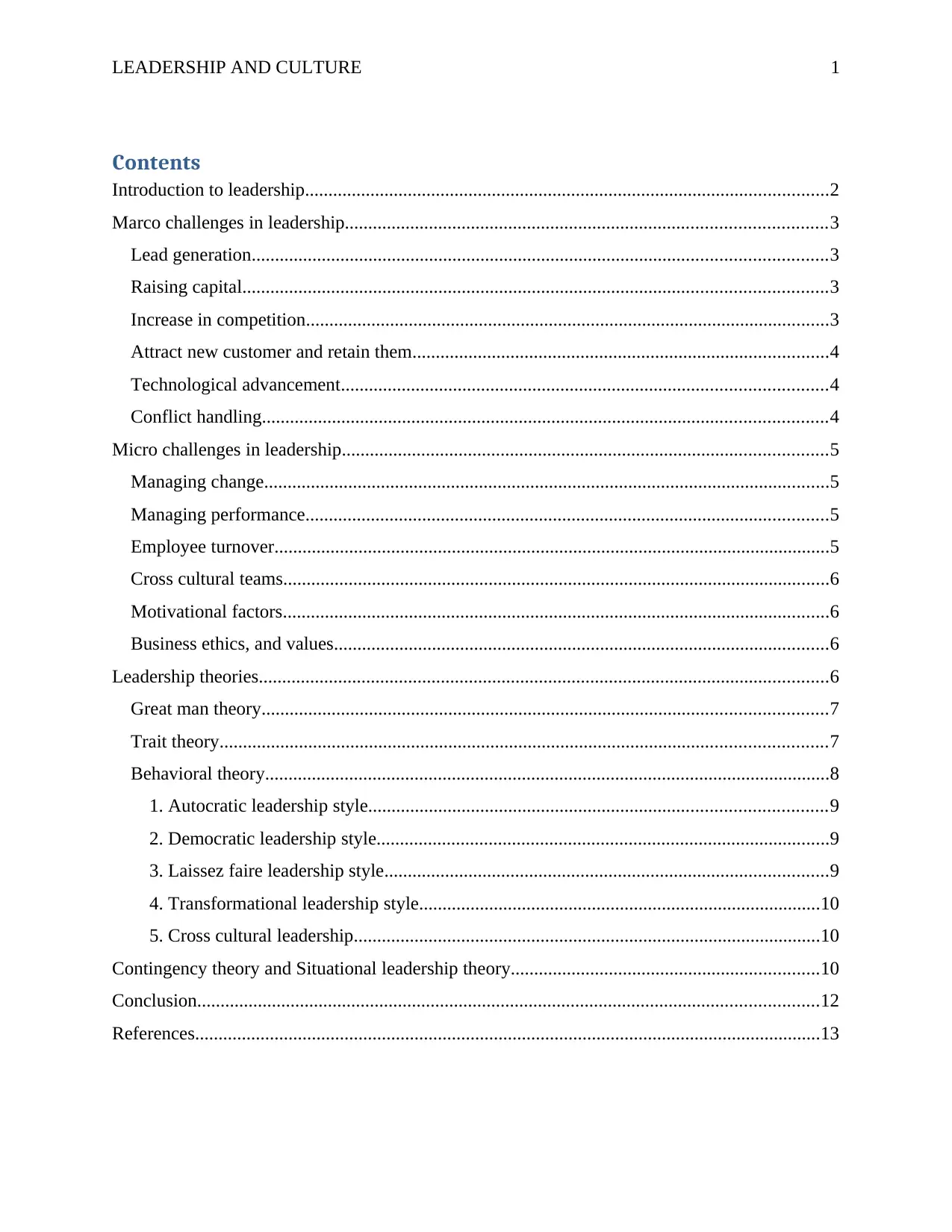
LEADERSHIP AND CULTURE 1
Contents
Introduction to leadership................................................................................................................2
Marco challenges in leadership.......................................................................................................3
Lead generation...........................................................................................................................3
Raising capital.............................................................................................................................3
Increase in competition................................................................................................................3
Attract new customer and retain them.........................................................................................4
Technological advancement........................................................................................................4
Conflict handling.........................................................................................................................4
Micro challenges in leadership........................................................................................................5
Managing change.........................................................................................................................5
Managing performance................................................................................................................5
Employee turnover.......................................................................................................................5
Cross cultural teams.....................................................................................................................6
Motivational factors.....................................................................................................................6
Business ethics, and values..........................................................................................................6
Leadership theories..........................................................................................................................6
Great man theory.........................................................................................................................7
Trait theory..................................................................................................................................7
Behavioral theory.........................................................................................................................8
1. Autocratic leadership style..................................................................................................9
2. Democratic leadership style.................................................................................................9
3. Laissez faire leadership style...............................................................................................9
4. Transformational leadership style......................................................................................10
5. Cross cultural leadership....................................................................................................10
Contingency theory and Situational leadership theory..................................................................10
Conclusion.....................................................................................................................................12
References......................................................................................................................................13
Contents
Introduction to leadership................................................................................................................2
Marco challenges in leadership.......................................................................................................3
Lead generation...........................................................................................................................3
Raising capital.............................................................................................................................3
Increase in competition................................................................................................................3
Attract new customer and retain them.........................................................................................4
Technological advancement........................................................................................................4
Conflict handling.........................................................................................................................4
Micro challenges in leadership........................................................................................................5
Managing change.........................................................................................................................5
Managing performance................................................................................................................5
Employee turnover.......................................................................................................................5
Cross cultural teams.....................................................................................................................6
Motivational factors.....................................................................................................................6
Business ethics, and values..........................................................................................................6
Leadership theories..........................................................................................................................6
Great man theory.........................................................................................................................7
Trait theory..................................................................................................................................7
Behavioral theory.........................................................................................................................8
1. Autocratic leadership style..................................................................................................9
2. Democratic leadership style.................................................................................................9
3. Laissez faire leadership style...............................................................................................9
4. Transformational leadership style......................................................................................10
5. Cross cultural leadership....................................................................................................10
Contingency theory and Situational leadership theory..................................................................10
Conclusion.....................................................................................................................................12
References......................................................................................................................................13
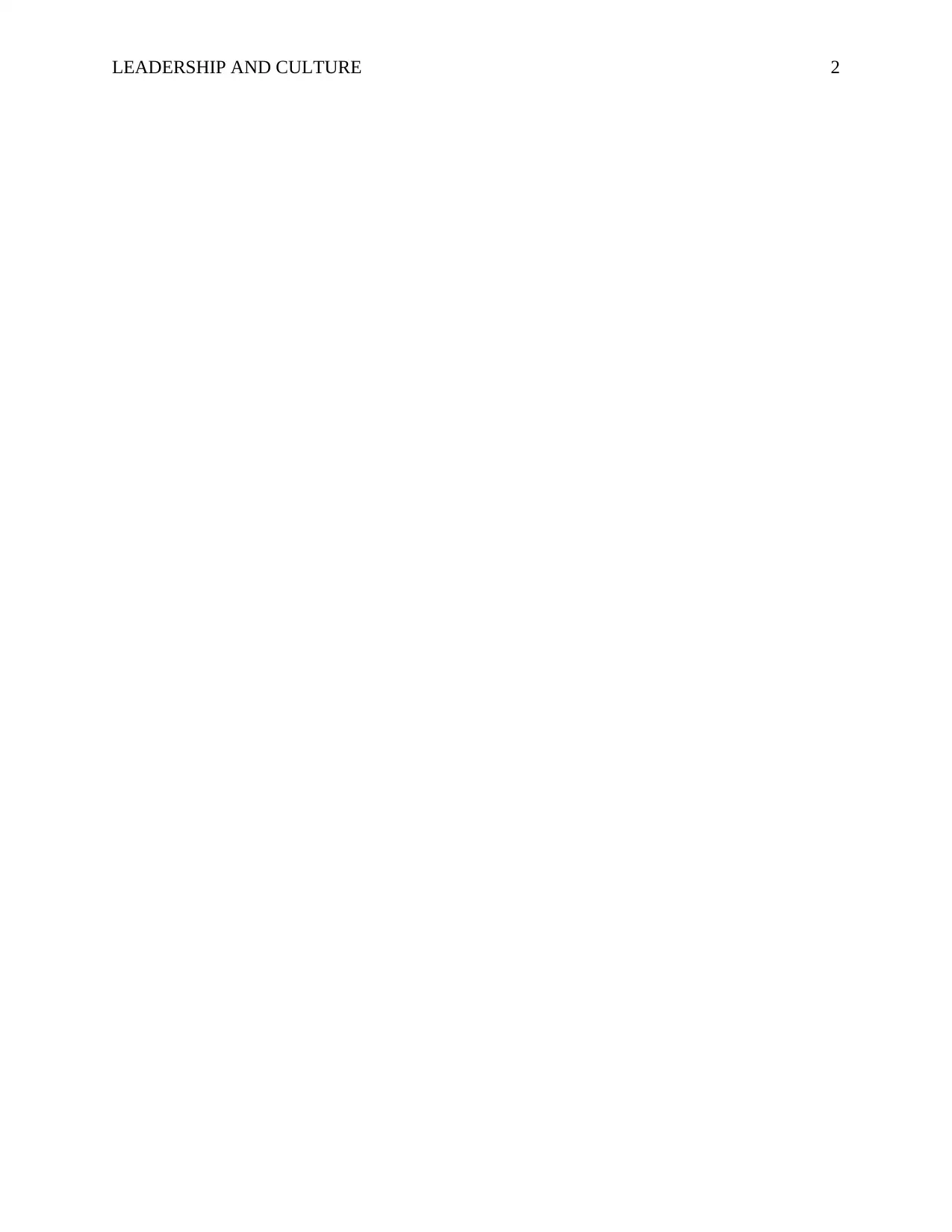
LEADERSHIP AND CULTURE 2
⊘ This is a preview!⊘
Do you want full access?
Subscribe today to unlock all pages.

Trusted by 1+ million students worldwide

LEADERSHIP AND CULTURE 3
Introduction to leadership
Leadership is one of the most important elements of an organization. Nevertheless, leadership is
leading a group of followers or people and it may be political leader, social leader, corporate
leader or any situation where an individual is leading a group of people is said to be leadership.
The report will include the discussion over the leadership in the organization. In an organization,
leading an organization is very challenging. Moreover, with an increase in multinational
corporations and international business opportunity, the leadership has become more challenging
and crucial in a company. The reason being a different culture is to be manager outside and
within the organization. The report’s purpose is to assess the key challenges that the leadership is
comprised of considering the macro and micro environment of the organization (Antonakis et al.,
2009).
The key role of the leader in an organization includes providing vision and direction to the staff
and the objectives that are to be accomplished in an organization. Moreover, the guidance,
authority, management, control, supervision, cross cultural management, motivation, team
management and various other activities are the key aspects that a leader considers to perform
the leadership effectively. Moreover, employee engagement, managing stakeholders as
shareholder, customer, government, an employee of the company are to be considered by a
leader. Moreover, the leadership theories and types of leadership are the key aspect of leadership
that will influence the effectiveness of the leadership and the suitability of the leadership style in
a particular situation (Birasnav, 2014).
Introduction to leadership
Leadership is one of the most important elements of an organization. Nevertheless, leadership is
leading a group of followers or people and it may be political leader, social leader, corporate
leader or any situation where an individual is leading a group of people is said to be leadership.
The report will include the discussion over the leadership in the organization. In an organization,
leading an organization is very challenging. Moreover, with an increase in multinational
corporations and international business opportunity, the leadership has become more challenging
and crucial in a company. The reason being a different culture is to be manager outside and
within the organization. The report’s purpose is to assess the key challenges that the leadership is
comprised of considering the macro and micro environment of the organization (Antonakis et al.,
2009).
The key role of the leader in an organization includes providing vision and direction to the staff
and the objectives that are to be accomplished in an organization. Moreover, the guidance,
authority, management, control, supervision, cross cultural management, motivation, team
management and various other activities are the key aspects that a leader considers to perform
the leadership effectively. Moreover, employee engagement, managing stakeholders as
shareholder, customer, government, an employee of the company are to be considered by a
leader. Moreover, the leadership theories and types of leadership are the key aspect of leadership
that will influence the effectiveness of the leadership and the suitability of the leadership style in
a particular situation (Birasnav, 2014).
Paraphrase This Document
Need a fresh take? Get an instant paraphrase of this document with our AI Paraphraser
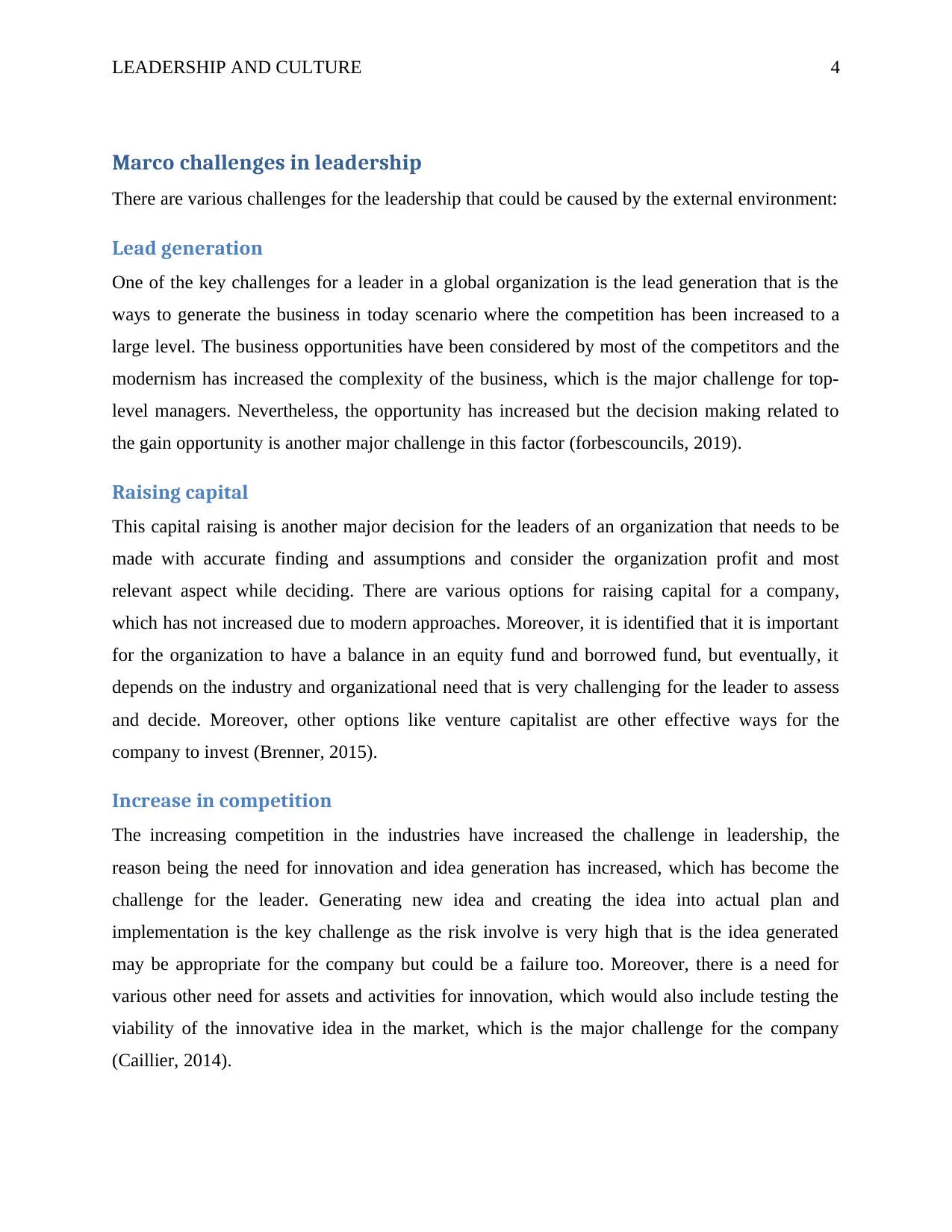
LEADERSHIP AND CULTURE 4
Marco challenges in leadership
There are various challenges for the leadership that could be caused by the external environment:
Lead generation
One of the key challenges for a leader in a global organization is the lead generation that is the
ways to generate the business in today scenario where the competition has been increased to a
large level. The business opportunities have been considered by most of the competitors and the
modernism has increased the complexity of the business, which is the major challenge for top-
level managers. Nevertheless, the opportunity has increased but the decision making related to
the gain opportunity is another major challenge in this factor (forbescouncils, 2019).
Raising capital
This capital raising is another major decision for the leaders of an organization that needs to be
made with accurate finding and assumptions and consider the organization profit and most
relevant aspect while deciding. There are various options for raising capital for a company,
which has not increased due to modern approaches. Moreover, it is identified that it is important
for the organization to have a balance in an equity fund and borrowed fund, but eventually, it
depends on the industry and organizational need that is very challenging for the leader to assess
and decide. Moreover, other options like venture capitalist are other effective ways for the
company to invest (Brenner, 2015).
Increase in competition
The increasing competition in the industries have increased the challenge in leadership, the
reason being the need for innovation and idea generation has increased, which has become the
challenge for the leader. Generating new idea and creating the idea into actual plan and
implementation is the key challenge as the risk involve is very high that is the idea generated
may be appropriate for the company but could be a failure too. Moreover, there is a need for
various other need for assets and activities for innovation, which would also include testing the
viability of the innovative idea in the market, which is the major challenge for the company
(Caillier, 2014).
Marco challenges in leadership
There are various challenges for the leadership that could be caused by the external environment:
Lead generation
One of the key challenges for a leader in a global organization is the lead generation that is the
ways to generate the business in today scenario where the competition has been increased to a
large level. The business opportunities have been considered by most of the competitors and the
modernism has increased the complexity of the business, which is the major challenge for top-
level managers. Nevertheless, the opportunity has increased but the decision making related to
the gain opportunity is another major challenge in this factor (forbescouncils, 2019).
Raising capital
This capital raising is another major decision for the leaders of an organization that needs to be
made with accurate finding and assumptions and consider the organization profit and most
relevant aspect while deciding. There are various options for raising capital for a company,
which has not increased due to modern approaches. Moreover, it is identified that it is important
for the organization to have a balance in an equity fund and borrowed fund, but eventually, it
depends on the industry and organizational need that is very challenging for the leader to assess
and decide. Moreover, other options like venture capitalist are other effective ways for the
company to invest (Brenner, 2015).
Increase in competition
The increasing competition in the industries have increased the challenge in leadership, the
reason being the need for innovation and idea generation has increased, which has become the
challenge for the leader. Generating new idea and creating the idea into actual plan and
implementation is the key challenge as the risk involve is very high that is the idea generated
may be appropriate for the company but could be a failure too. Moreover, there is a need for
various other need for assets and activities for innovation, which would also include testing the
viability of the innovative idea in the market, which is the major challenge for the company
(Caillier, 2014).
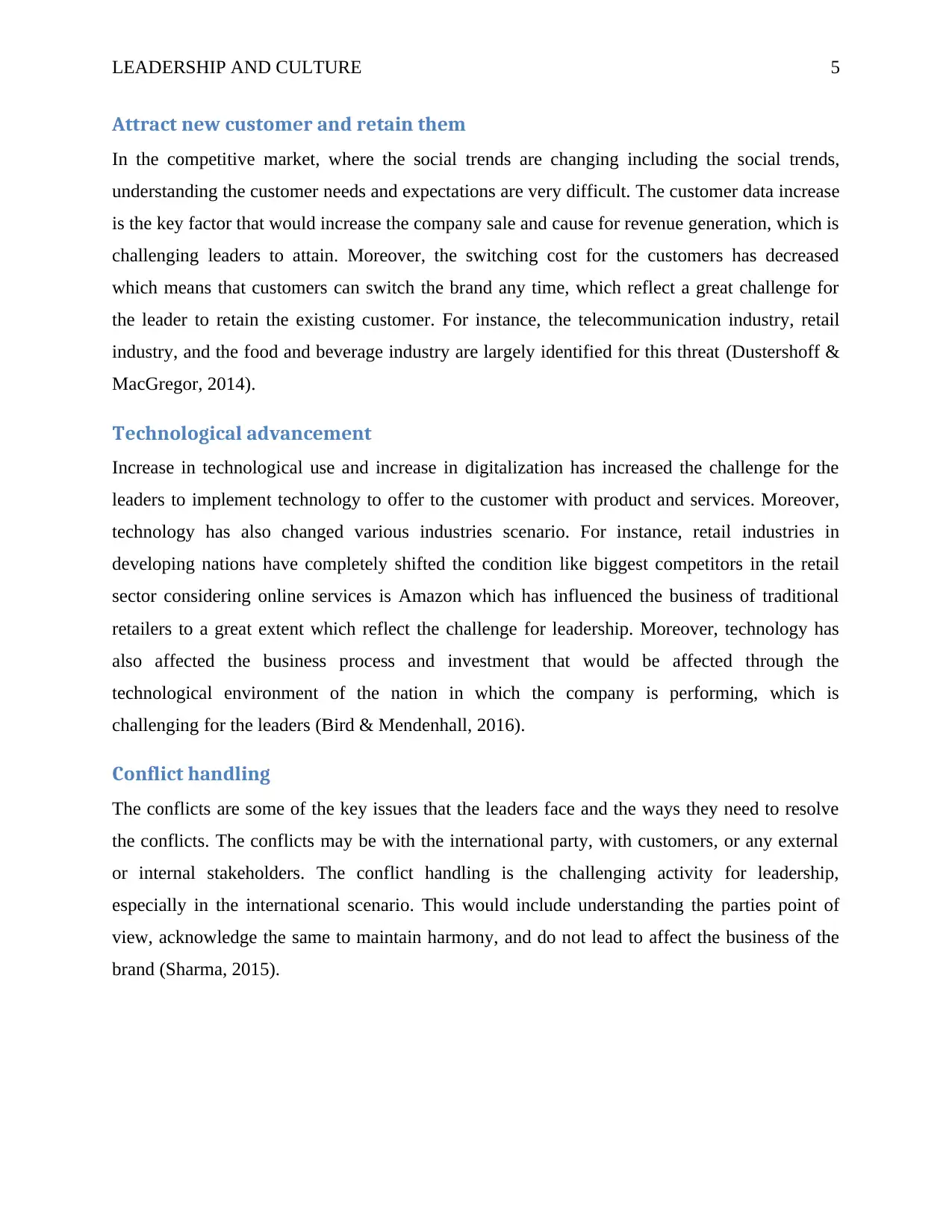
LEADERSHIP AND CULTURE 5
Attract new customer and retain them
In the competitive market, where the social trends are changing including the social trends,
understanding the customer needs and expectations are very difficult. The customer data increase
is the key factor that would increase the company sale and cause for revenue generation, which is
challenging leaders to attain. Moreover, the switching cost for the customers has decreased
which means that customers can switch the brand any time, which reflect a great challenge for
the leader to retain the existing customer. For instance, the telecommunication industry, retail
industry, and the food and beverage industry are largely identified for this threat (Dustershoff &
MacGregor, 2014).
Technological advancement
Increase in technological use and increase in digitalization has increased the challenge for the
leaders to implement technology to offer to the customer with product and services. Moreover,
technology has also changed various industries scenario. For instance, retail industries in
developing nations have completely shifted the condition like biggest competitors in the retail
sector considering online services is Amazon which has influenced the business of traditional
retailers to a great extent which reflect the challenge for leadership. Moreover, technology has
also affected the business process and investment that would be affected through the
technological environment of the nation in which the company is performing, which is
challenging for the leaders (Bird & Mendenhall, 2016).
Conflict handling
The conflicts are some of the key issues that the leaders face and the ways they need to resolve
the conflicts. The conflicts may be with the international party, with customers, or any external
or internal stakeholders. The conflict handling is the challenging activity for leadership,
especially in the international scenario. This would include understanding the parties point of
view, acknowledge the same to maintain harmony, and do not lead to affect the business of the
brand (Sharma, 2015).
Attract new customer and retain them
In the competitive market, where the social trends are changing including the social trends,
understanding the customer needs and expectations are very difficult. The customer data increase
is the key factor that would increase the company sale and cause for revenue generation, which is
challenging leaders to attain. Moreover, the switching cost for the customers has decreased
which means that customers can switch the brand any time, which reflect a great challenge for
the leader to retain the existing customer. For instance, the telecommunication industry, retail
industry, and the food and beverage industry are largely identified for this threat (Dustershoff &
MacGregor, 2014).
Technological advancement
Increase in technological use and increase in digitalization has increased the challenge for the
leaders to implement technology to offer to the customer with product and services. Moreover,
technology has also changed various industries scenario. For instance, retail industries in
developing nations have completely shifted the condition like biggest competitors in the retail
sector considering online services is Amazon which has influenced the business of traditional
retailers to a great extent which reflect the challenge for leadership. Moreover, technology has
also affected the business process and investment that would be affected through the
technological environment of the nation in which the company is performing, which is
challenging for the leaders (Bird & Mendenhall, 2016).
Conflict handling
The conflicts are some of the key issues that the leaders face and the ways they need to resolve
the conflicts. The conflicts may be with the international party, with customers, or any external
or internal stakeholders. The conflict handling is the challenging activity for leadership,
especially in the international scenario. This would include understanding the parties point of
view, acknowledge the same to maintain harmony, and do not lead to affect the business of the
brand (Sharma, 2015).
⊘ This is a preview!⊘
Do you want full access?
Subscribe today to unlock all pages.

Trusted by 1+ million students worldwide
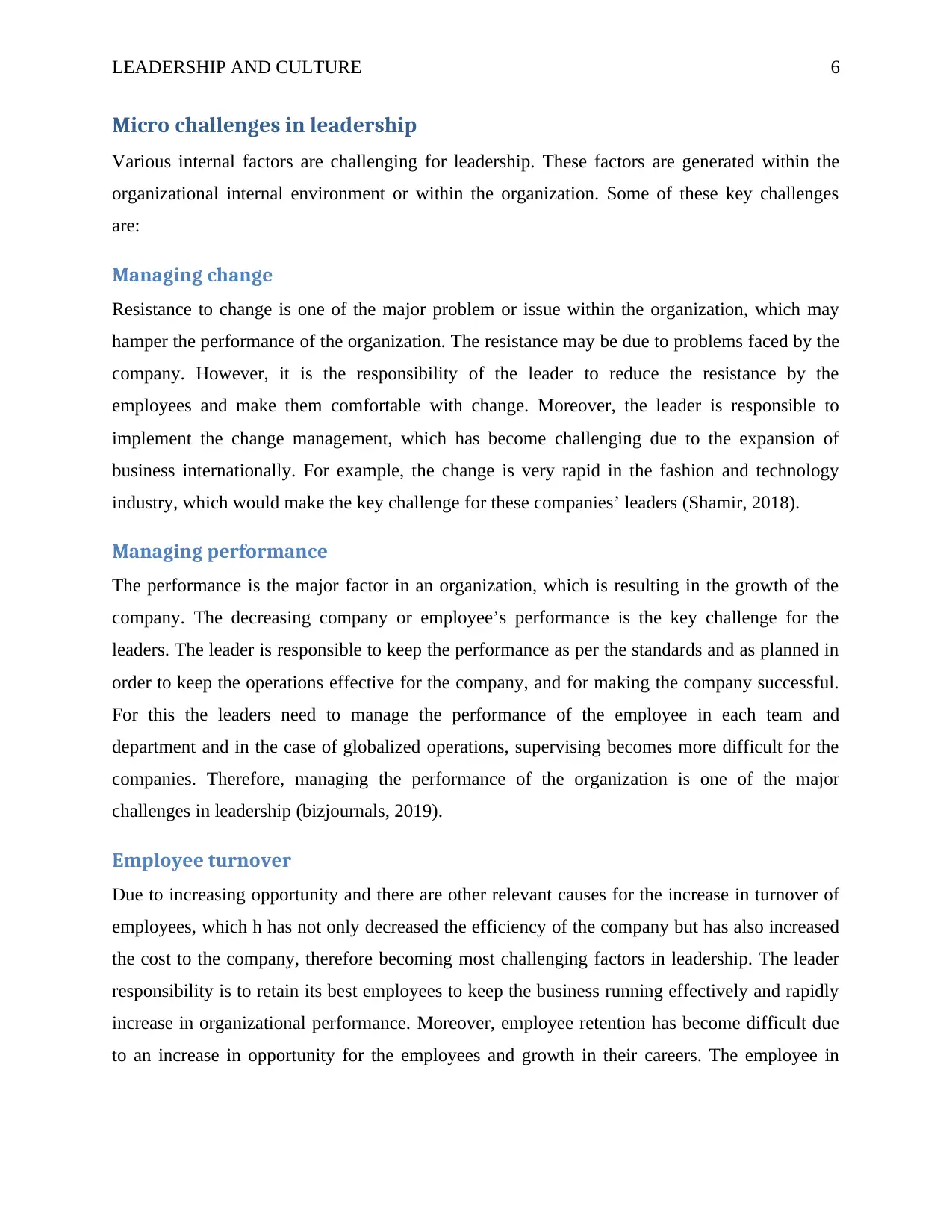
LEADERSHIP AND CULTURE 6
Micro challenges in leadership
Various internal factors are challenging for leadership. These factors are generated within the
organizational internal environment or within the organization. Some of these key challenges
are:
Managing change
Resistance to change is one of the major problem or issue within the organization, which may
hamper the performance of the organization. The resistance may be due to problems faced by the
company. However, it is the responsibility of the leader to reduce the resistance by the
employees and make them comfortable with change. Moreover, the leader is responsible to
implement the change management, which has become challenging due to the expansion of
business internationally. For example, the change is very rapid in the fashion and technology
industry, which would make the key challenge for these companies’ leaders (Shamir, 2018).
Managing performance
The performance is the major factor in an organization, which is resulting in the growth of the
company. The decreasing company or employee’s performance is the key challenge for the
leaders. The leader is responsible to keep the performance as per the standards and as planned in
order to keep the operations effective for the company, and for making the company successful.
For this the leaders need to manage the performance of the employee in each team and
department and in the case of globalized operations, supervising becomes more difficult for the
companies. Therefore, managing the performance of the organization is one of the major
challenges in leadership (bizjournals, 2019).
Employee turnover
Due to increasing opportunity and there are other relevant causes for the increase in turnover of
employees, which h has not only decreased the efficiency of the company but has also increased
the cost to the company, therefore becoming most challenging factors in leadership. The leader
responsibility is to retain its best employees to keep the business running effectively and rapidly
increase in organizational performance. Moreover, employee retention has become difficult due
to an increase in opportunity for the employees and growth in their careers. The employee in
Micro challenges in leadership
Various internal factors are challenging for leadership. These factors are generated within the
organizational internal environment or within the organization. Some of these key challenges
are:
Managing change
Resistance to change is one of the major problem or issue within the organization, which may
hamper the performance of the organization. The resistance may be due to problems faced by the
company. However, it is the responsibility of the leader to reduce the resistance by the
employees and make them comfortable with change. Moreover, the leader is responsible to
implement the change management, which has become challenging due to the expansion of
business internationally. For example, the change is very rapid in the fashion and technology
industry, which would make the key challenge for these companies’ leaders (Shamir, 2018).
Managing performance
The performance is the major factor in an organization, which is resulting in the growth of the
company. The decreasing company or employee’s performance is the key challenge for the
leaders. The leader is responsible to keep the performance as per the standards and as planned in
order to keep the operations effective for the company, and for making the company successful.
For this the leaders need to manage the performance of the employee in each team and
department and in the case of globalized operations, supervising becomes more difficult for the
companies. Therefore, managing the performance of the organization is one of the major
challenges in leadership (bizjournals, 2019).
Employee turnover
Due to increasing opportunity and there are other relevant causes for the increase in turnover of
employees, which h has not only decreased the efficiency of the company but has also increased
the cost to the company, therefore becoming most challenging factors in leadership. The leader
responsibility is to retain its best employees to keep the business running effectively and rapidly
increase in organizational performance. Moreover, employee retention has become difficult due
to an increase in opportunity for the employees and growth in their careers. The employee in
Paraphrase This Document
Need a fresh take? Get an instant paraphrase of this document with our AI Paraphraser
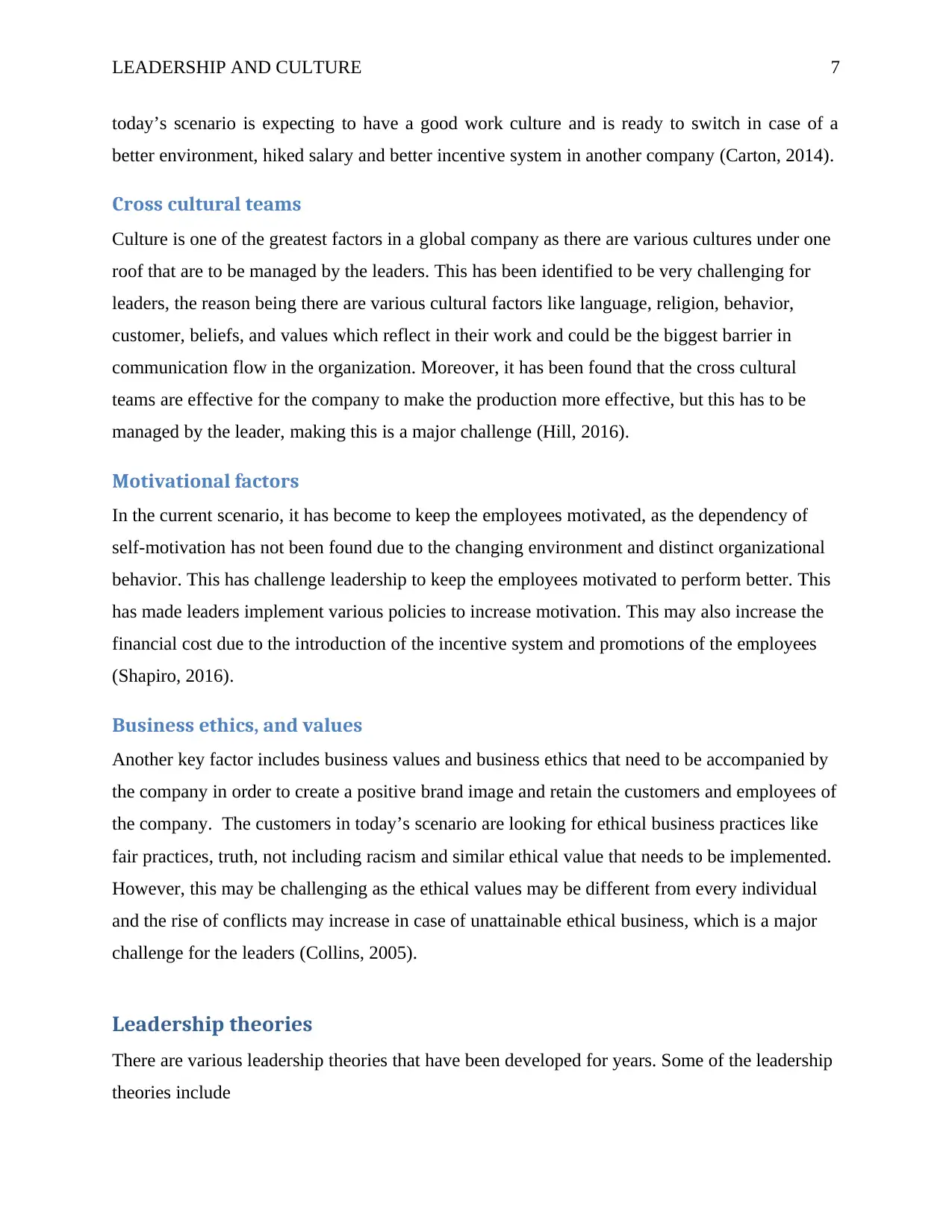
LEADERSHIP AND CULTURE 7
today’s scenario is expecting to have a good work culture and is ready to switch in case of a
better environment, hiked salary and better incentive system in another company (Carton, 2014).
Cross cultural teams
Culture is one of the greatest factors in a global company as there are various cultures under one
roof that are to be managed by the leaders. This has been identified to be very challenging for
leaders, the reason being there are various cultural factors like language, religion, behavior,
customer, beliefs, and values which reflect in their work and could be the biggest barrier in
communication flow in the organization. Moreover, it has been found that the cross cultural
teams are effective for the company to make the production more effective, but this has to be
managed by the leader, making this is a major challenge (Hill, 2016).
Motivational factors
In the current scenario, it has become to keep the employees motivated, as the dependency of
self-motivation has not been found due to the changing environment and distinct organizational
behavior. This has challenge leadership to keep the employees motivated to perform better. This
has made leaders implement various policies to increase motivation. This may also increase the
financial cost due to the introduction of the incentive system and promotions of the employees
(Shapiro, 2016).
Business ethics, and values
Another key factor includes business values and business ethics that need to be accompanied by
the company in order to create a positive brand image and retain the customers and employees of
the company. The customers in today’s scenario are looking for ethical business practices like
fair practices, truth, not including racism and similar ethical value that needs to be implemented.
However, this may be challenging as the ethical values may be different from every individual
and the rise of conflicts may increase in case of unattainable ethical business, which is a major
challenge for the leaders (Collins, 2005).
Leadership theories
There are various leadership theories that have been developed for years. Some of the leadership
theories include
today’s scenario is expecting to have a good work culture and is ready to switch in case of a
better environment, hiked salary and better incentive system in another company (Carton, 2014).
Cross cultural teams
Culture is one of the greatest factors in a global company as there are various cultures under one
roof that are to be managed by the leaders. This has been identified to be very challenging for
leaders, the reason being there are various cultural factors like language, religion, behavior,
customer, beliefs, and values which reflect in their work and could be the biggest barrier in
communication flow in the organization. Moreover, it has been found that the cross cultural
teams are effective for the company to make the production more effective, but this has to be
managed by the leader, making this is a major challenge (Hill, 2016).
Motivational factors
In the current scenario, it has become to keep the employees motivated, as the dependency of
self-motivation has not been found due to the changing environment and distinct organizational
behavior. This has challenge leadership to keep the employees motivated to perform better. This
has made leaders implement various policies to increase motivation. This may also increase the
financial cost due to the introduction of the incentive system and promotions of the employees
(Shapiro, 2016).
Business ethics, and values
Another key factor includes business values and business ethics that need to be accompanied by
the company in order to create a positive brand image and retain the customers and employees of
the company. The customers in today’s scenario are looking for ethical business practices like
fair practices, truth, not including racism and similar ethical value that needs to be implemented.
However, this may be challenging as the ethical values may be different from every individual
and the rise of conflicts may increase in case of unattainable ethical business, which is a major
challenge for the leaders (Collins, 2005).
Leadership theories
There are various leadership theories that have been developed for years. Some of the leadership
theories include

LEADERSHIP AND CULTURE 8
Great man theory
This is the traditional theory of leadership, which depicts that the leaders are born, not made.
According to this theory, the leadership qualities are in the build that is the traits of leadership
are visible since childhood and not developed later on. It has been believing that some of the key
leaders were found to have leadership traits by birth instead of learning leadership in their later
ages. Some of the examples of born leaders is Abraham Lincoln, Mahatma Gandhi, and Kamal
Ataturk. It has been believed that these have the leadership qualities by the greatness of divine
and are naturally born leaders. However, this theory has been criticized to a large extent and
there has been generated. They were not trained to lead a team and if they was always able to
make their followers who were willing to listen to them. This could be the personality or
physiology that has gained them this position (Santos, 2015).
The key aspects that were raised by other theories include that the theory is questioning the
empirical validity of the theory, and no scientific basis says that people are born leader.
Moreover, other negative points of this theory include that there as no evidence for inborn,
mysterious, and divines regarding the qualities of the leaders, these are the imaginary character
that the theory depicts. Moreover, later it has been identified that leaders are simple mortals that
consist of certain skills that could be helpful for influencing a group of people and could be
sharpened with education (D’Innocenzo, 2016).
Trait theory
This theory is opposite to that of great man theory, according to these theory leadership traits and
qualities can be acquired, it is not always necessary that the leaders are born. Moreover, this
theory also comprises of identifiable characteristics and qualities that are approachable for being
a leader. The traits that are commonly observed and can be trained and practice:
1. Intelligence – It has been observed that in order to make people influence the followers it is
essential for the people to be intelligent and have adequate knowledge to attract others to listen to
their points. Good leaders need to have enough understanding of the situation and environmental
variable to support the being leaders (Oostlander, 2014).
2. Personality – another trait that is essential for being a leader is the personality of the leader,
this does not include the physical appearance of the individual. Other than the outer experience,
Great man theory
This is the traditional theory of leadership, which depicts that the leaders are born, not made.
According to this theory, the leadership qualities are in the build that is the traits of leadership
are visible since childhood and not developed later on. It has been believing that some of the key
leaders were found to have leadership traits by birth instead of learning leadership in their later
ages. Some of the examples of born leaders is Abraham Lincoln, Mahatma Gandhi, and Kamal
Ataturk. It has been believed that these have the leadership qualities by the greatness of divine
and are naturally born leaders. However, this theory has been criticized to a large extent and
there has been generated. They were not trained to lead a team and if they was always able to
make their followers who were willing to listen to them. This could be the personality or
physiology that has gained them this position (Santos, 2015).
The key aspects that were raised by other theories include that the theory is questioning the
empirical validity of the theory, and no scientific basis says that people are born leader.
Moreover, other negative points of this theory include that there as no evidence for inborn,
mysterious, and divines regarding the qualities of the leaders, these are the imaginary character
that the theory depicts. Moreover, later it has been identified that leaders are simple mortals that
consist of certain skills that could be helpful for influencing a group of people and could be
sharpened with education (D’Innocenzo, 2016).
Trait theory
This theory is opposite to that of great man theory, according to these theory leadership traits and
qualities can be acquired, it is not always necessary that the leaders are born. Moreover, this
theory also comprises of identifiable characteristics and qualities that are approachable for being
a leader. The traits that are commonly observed and can be trained and practice:
1. Intelligence – It has been observed that in order to make people influence the followers it is
essential for the people to be intelligent and have adequate knowledge to attract others to listen to
their points. Good leaders need to have enough understanding of the situation and environmental
variable to support the being leaders (Oostlander, 2014).
2. Personality – another trait that is essential for being a leader is the personality of the leader,
this does not include the physical appearance of the individual. Other than the outer experience,
⊘ This is a preview!⊘
Do you want full access?
Subscribe today to unlock all pages.

Trusted by 1+ million students worldwide

LEADERSHIP AND CULTURE 9
the inner quality of a person affects the leadership like emotional stability, self-confidence,
strong drive, decisiveness, optimism, achievement orientation, integrity in character,
extremeness, communication skills. These traits include three aspects that are the abilities of an
individual, personal traits, and the motivators to perform better.
Other traits that can be trained include ambition and energy, honesty and integrity the desire to
lead, and social skills.
Various positive aspects are the scope for every individual to gain the skills and be competent to
become a leader in the near future. However, there were various limitations identified in this
theory. The key limitations of this theory include:
1. It is not possible to predict leadership in every possible situation, people, need to react
differently in every situation and there are no universal traits of leadership, in fact there would be
limitless traits of a leader.
2. Traits are able to depict theleader's behavior better in case of weaker situations than that of
strong.
3. There is no evidence of the theory and the cause and effect of the traits of leaders are unclear.
4. This theory is inward looking that cannot be alone exclusive for the task situation (Cherry,
2018).
Behavioral theory
After trait theory is criticized, the behavioral theory depicts that the leadership is comprised of
what leaders are doing that is the leadership is dependent on the actions or behavior of a leader
instead of their traits. Effective role behavior is considered to be leaders to a good leader and this
was the base to the approach by this theory. Theory reflects the specific behavior of individuals,
the inner quality of a person affects the leadership like emotional stability, self-confidence,
strong drive, decisiveness, optimism, achievement orientation, integrity in character,
extremeness, communication skills. These traits include three aspects that are the abilities of an
individual, personal traits, and the motivators to perform better.
Other traits that can be trained include ambition and energy, honesty and integrity the desire to
lead, and social skills.
Various positive aspects are the scope for every individual to gain the skills and be competent to
become a leader in the near future. However, there were various limitations identified in this
theory. The key limitations of this theory include:
1. It is not possible to predict leadership in every possible situation, people, need to react
differently in every situation and there are no universal traits of leadership, in fact there would be
limitless traits of a leader.
2. Traits are able to depict theleader's behavior better in case of weaker situations than that of
strong.
3. There is no evidence of the theory and the cause and effect of the traits of leaders are unclear.
4. This theory is inward looking that cannot be alone exclusive for the task situation (Cherry,
2018).
Behavioral theory
After trait theory is criticized, the behavioral theory depicts that the leadership is comprised of
what leaders are doing that is the leadership is dependent on the actions or behavior of a leader
instead of their traits. Effective role behavior is considered to be leaders to a good leader and this
was the base to the approach by this theory. Theory reflects the specific behavior of individuals,
Paraphrase This Document
Need a fresh take? Get an instant paraphrase of this document with our AI Paraphraser

LEADERSHIP AND CULTURE 10
which are able to differentiate the leaders and the non-leaders. This would include the action
patterns used by various individuals that are reflecting leadership potential. This theory included
the leadership styles that are implemented by the individuals, which reflect their leadership
behavior. Some of these styles include:
1. Autocratic leadership style
According to this theory, the leaders are more of bossy nature that is they believing themselves
more than their team when making any decisions. These leaders inspire their team members but
the decision making authority is centralized that is in their hands and they implemented the
decision and asked others to do what is instructed. This leadership style is possible in case of
managing the large business and it is not possible to listen to everyone point. The example of an
autocratic leader is Donald Trump (Jing, 2016).
2. Democratic leadership style
The Democratic leaders are the leaders who prefer to in decentralization and listen to their
employees before taking any decision. As per this style, people are friendly and communicate to
their employees to understand their viewpoint and make the decision by themselves. This is
essential to keep the employees motivated in the organization. The most relevant feature of
behavior observed in this style is the communication in the organization that is free and is
suitable in case of innovative organizational culture as it is important for the top manager to
generate innovative ideas from and authority to the employees to share their thought and ideas.
This is one of the most preferred leadership styles in today’s scenario that also preferable by the
employees too as they feel important in the company because they are being listened. One of the
examples of a democratic leader is “George Washington.” Moreover, the most suitable industry
for this leadership style is high tech and medical industries (Zhao, 2016).
3. Laissez faire leadership style
According to this leadership style, the authority of taking decision are in the hands of employees
and not kept in the hands of the leaders. The environment is very relaxed and employees are kept
self-motivated due to responsibility and authority of the task to be accomplished. This leadership
style is challenging, as the decision made by the team could be not right, as they are not
experienced. In addition, this is not possible in case of the new enterprise as the experience of the
which are able to differentiate the leaders and the non-leaders. This would include the action
patterns used by various individuals that are reflecting leadership potential. This theory included
the leadership styles that are implemented by the individuals, which reflect their leadership
behavior. Some of these styles include:
1. Autocratic leadership style
According to this theory, the leaders are more of bossy nature that is they believing themselves
more than their team when making any decisions. These leaders inspire their team members but
the decision making authority is centralized that is in their hands and they implemented the
decision and asked others to do what is instructed. This leadership style is possible in case of
managing the large business and it is not possible to listen to everyone point. The example of an
autocratic leader is Donald Trump (Jing, 2016).
2. Democratic leadership style
The Democratic leaders are the leaders who prefer to in decentralization and listen to their
employees before taking any decision. As per this style, people are friendly and communicate to
their employees to understand their viewpoint and make the decision by themselves. This is
essential to keep the employees motivated in the organization. The most relevant feature of
behavior observed in this style is the communication in the organization that is free and is
suitable in case of innovative organizational culture as it is important for the top manager to
generate innovative ideas from and authority to the employees to share their thought and ideas.
This is one of the most preferred leadership styles in today’s scenario that also preferable by the
employees too as they feel important in the company because they are being listened. One of the
examples of a democratic leader is “George Washington.” Moreover, the most suitable industry
for this leadership style is high tech and medical industries (Zhao, 2016).
3. Laissez faire leadership style
According to this leadership style, the authority of taking decision are in the hands of employees
and not kept in the hands of the leaders. The environment is very relaxed and employees are kept
self-motivated due to responsibility and authority of the task to be accomplished. This leadership
style is challenging, as the decision made by the team could be not right, as they are not
experienced. In addition, this is not possible in case of the new enterprise as the experience of the
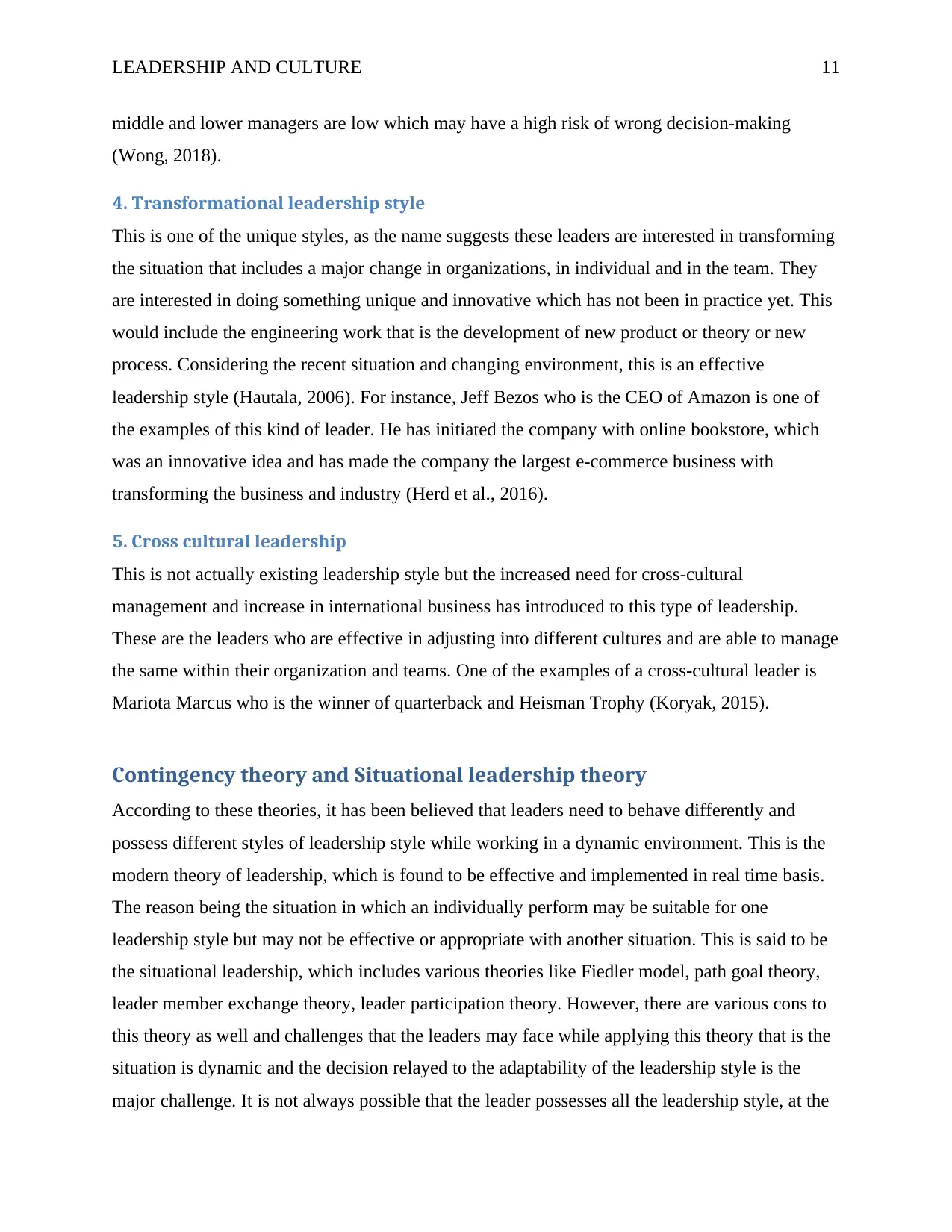
LEADERSHIP AND CULTURE 11
middle and lower managers are low which may have a high risk of wrong decision-making
(Wong, 2018).
4. Transformational leadership style
This is one of the unique styles, as the name suggests these leaders are interested in transforming
the situation that includes a major change in organizations, in individual and in the team. They
are interested in doing something unique and innovative which has not been in practice yet. This
would include the engineering work that is the development of new product or theory or new
process. Considering the recent situation and changing environment, this is an effective
leadership style (Hautala, 2006). For instance, Jeff Bezos who is the CEO of Amazon is one of
the examples of this kind of leader. He has initiated the company with online bookstore, which
was an innovative idea and has made the company the largest e-commerce business with
transforming the business and industry (Herd et al., 2016).
5. Cross cultural leadership
This is not actually existing leadership style but the increased need for cross-cultural
management and increase in international business has introduced to this type of leadership.
These are the leaders who are effective in adjusting into different cultures and are able to manage
the same within their organization and teams. One of the examples of a cross-cultural leader is
Mariota Marcus who is the winner of quarterback and Heisman Trophy (Koryak, 2015).
Contingency theory and Situational leadership theory
According to these theories, it has been believed that leaders need to behave differently and
possess different styles of leadership style while working in a dynamic environment. This is the
modern theory of leadership, which is found to be effective and implemented in real time basis.
The reason being the situation in which an individually perform may be suitable for one
leadership style but may not be effective or appropriate with another situation. This is said to be
the situational leadership, which includes various theories like Fiedler model, path goal theory,
leader member exchange theory, leader participation theory. However, there are various cons to
this theory as well and challenges that the leaders may face while applying this theory that is the
situation is dynamic and the decision relayed to the adaptability of the leadership style is the
major challenge. It is not always possible that the leader possesses all the leadership style, at the
middle and lower managers are low which may have a high risk of wrong decision-making
(Wong, 2018).
4. Transformational leadership style
This is one of the unique styles, as the name suggests these leaders are interested in transforming
the situation that includes a major change in organizations, in individual and in the team. They
are interested in doing something unique and innovative which has not been in practice yet. This
would include the engineering work that is the development of new product or theory or new
process. Considering the recent situation and changing environment, this is an effective
leadership style (Hautala, 2006). For instance, Jeff Bezos who is the CEO of Amazon is one of
the examples of this kind of leader. He has initiated the company with online bookstore, which
was an innovative idea and has made the company the largest e-commerce business with
transforming the business and industry (Herd et al., 2016).
5. Cross cultural leadership
This is not actually existing leadership style but the increased need for cross-cultural
management and increase in international business has introduced to this type of leadership.
These are the leaders who are effective in adjusting into different cultures and are able to manage
the same within their organization and teams. One of the examples of a cross-cultural leader is
Mariota Marcus who is the winner of quarterback and Heisman Trophy (Koryak, 2015).
Contingency theory and Situational leadership theory
According to these theories, it has been believed that leaders need to behave differently and
possess different styles of leadership style while working in a dynamic environment. This is the
modern theory of leadership, which is found to be effective and implemented in real time basis.
The reason being the situation in which an individually perform may be suitable for one
leadership style but may not be effective or appropriate with another situation. This is said to be
the situational leadership, which includes various theories like Fiedler model, path goal theory,
leader member exchange theory, leader participation theory. However, there are various cons to
this theory as well and challenges that the leaders may face while applying this theory that is the
situation is dynamic and the decision relayed to the adaptability of the leadership style is the
major challenge. It is not always possible that the leader possesses all the leadership style, at the
⊘ This is a preview!⊘
Do you want full access?
Subscribe today to unlock all pages.

Trusted by 1+ million students worldwide
1 out of 17
Related Documents
Your All-in-One AI-Powered Toolkit for Academic Success.
+13062052269
info@desklib.com
Available 24*7 on WhatsApp / Email
![[object Object]](/_next/static/media/star-bottom.7253800d.svg)
Unlock your academic potential
Copyright © 2020–2025 A2Z Services. All Rights Reserved. Developed and managed by ZUCOL.





